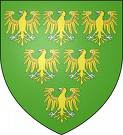Ever since the remarkable story of the discovery of 'The King in the car park', Richard III's remains discovered in a Leicester car park, I have planned to visit the site/Richard III centre. Plans have fallen through at least twice, so this Easter, I decided I was going to go. I'm a 'traditionalist' when it comes to Richard III, seeing him as a man of his times, and either re-acting to or instigating the circumstances he found himself in. Whatever you think of Richard, the story is a remarkable one, and I understand plans are afoot to make some sort of film about the project. Anyway, the Richard III centre is right opposite the Cathedral where Richard is buried, where the famous statue of Richard and his crown are sited.
I paid the admission price and headed into the centre. It was easy to spend an hour and a half there, so good is the exhibition. There's a film introducing Richard's story, seen from those around him - his brother, Edward IV, the Earl of Warwick, his mother Cecily Neville, his armourer and Anne Neville, his wife. To the left of the screening is a room charting the dig and project in pictures.
You then head off to the lower floor of the exhibition, featuring a timeline of Richard's life and his links with Leicester, culminating in the battle of Bosworth and his burial. Upstairs, it's all about the dig, with various models showing Leicester at the time of Richard's burial and mini documentaries telling the story of the dig. I appreciate all Philippa Langley has achieved, but my favourite Richardian is John Ashdown Hill and his meticulous research into the final resting place of Richard. Both Langley and Ashdown Hill feature heavily in the exhibition. There's a mock-up of Richard's skeleton with an interaction section, telling you about the wounds he suffered, and of course, the famous reconstruction of Richard's head, and how it was made.
Back downstairs you enter a room with a glass-topped floor - yes, it's the infamous car park, and you can look down into Richard's grave. The effect of a projection of a skeleton in the position of the body every few minutes is quite disconcerting at first!
A case of now you see him, now you don't! It's all very respectful and the volunteers I met there were expert in their knowledge - they really made my visit! The Grey Friars Church was actually very small in size, and the building of a Tudor house after the friary was dissolved meant that Richard's remains lay beneath the garden/orchard of the house - and the garden remained there for many years, even surviving the buildings of a school and the Victorian houses later built around the site. Richard's feet were lost with the building of a Victorian outhouse, but the rest of the garden survived until the site was covered in tarmac to provide parking for the staff working for Leicester City Council! Here's a picture of the rest of the car park - yes, it's still in use!
Whether you are a Ricardian or not, 'into' history or not, this centre is well worth a visit. It's a fascinating story.
Richard was re-buried in Leicester Cathedral, right opposite the centre. I was surprised at how small the cathedral is, but it's a fitting site for Richard to be buried. I personally feel he should have been re-buried in Leicester, as it's a few hundred metres from where he originally lay, and after all, he had been buried there 500 years previously. Here are the pictures I took.
Richard's tomb and his heraldic symbols at Leicester Cathedral.
This cloth covered Richard's coffin during his re-burial service, and the crown below was placed on it.
1 week ago










